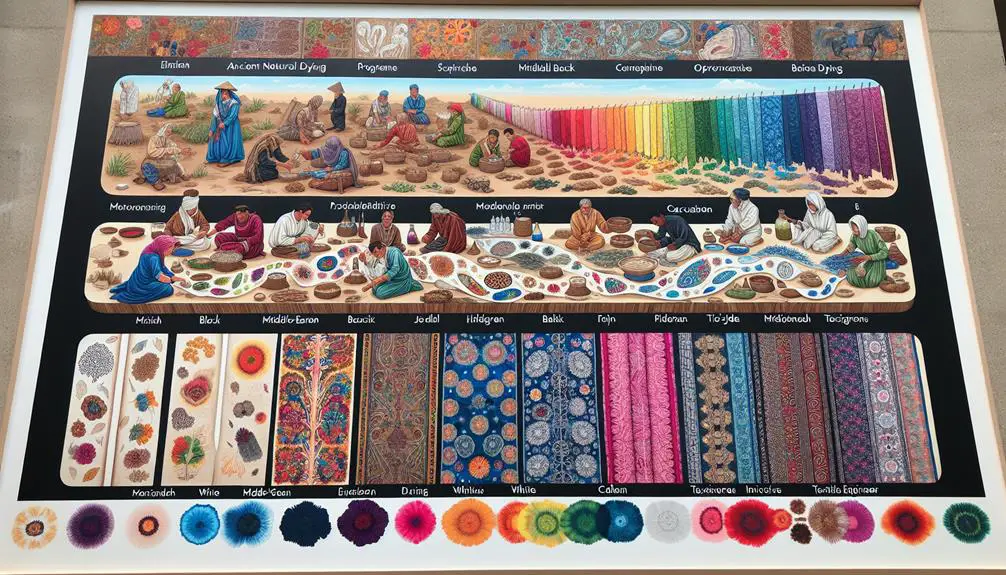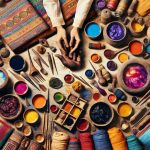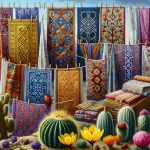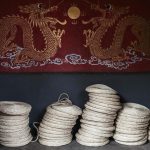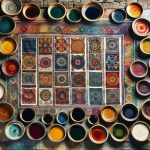When you think about fabric dyeing, you might picture vibrant colors and intricate patterns, but the story behind these techniques is far more intriguing. From the ancient Egyptians using madder roots and indigo plants to medieval Europeans perfecting their art with woad and mordants, each era has its unique contributions. Asian cultures, with their use of turmeric and safflower, also added to this rich tapestry. And then came the industrial revolution, which transformed the process entirely. So, how did these ancient practices evolve into the sophisticated dyeing methods we use today? Let's explore that journey.
Table of Contents
Key Takeaways
- Ancient civilizations used natural dyes from plants, insects, and minerals for vibrant fabric colors.
- Medieval Europeans employed mordants like alum and iron for colorfastness and vibrant hues.
- Asian cultures pioneered indigo extraction techniques and Shibori tie-dye for intricate patterns.
- The Industrial Revolution introduced automated processes, increasing efficiency and reducing costs in fabric dyeing.
- Synthetic dyes emerged in the 19th century, offering a broader color spectrum and consistent results, but causing environmental concerns.
Ancient Dyeing Methods
In ancient times, people discovered natural dyes from plants, insects, and minerals to color their fabrics. By mastering these natural dye origins, they crafted vibrant textiles that stood the test of time.
You can explore ancient dye recipes to appreciate the ingenuity of early civilizations. They didn't have synthetic dyes, so they relied on their keen observations and experiments with nature.
Take, for instance, the Egyptians. They used madder roots to produce red hues and indigo plants for deep blues. You'll find that the Greeks and Romans perfected recipes using murex snails to extract Tyrian purple, a highly prized dye. The meticulous process involved boiling the snails and fermenting the liquid to achieve the rich purple color.
In Asia, particularly in China and India, ancient dye recipes involved plants like turmeric for yellow and safflower for red. These cultures not only dyed fabrics but also shared their knowledge through trade, thereby influencing dyeing techniques worldwide.
As you investigate these ancient methods, notice the precision and patience required. By understanding these origins, you'll gain a deeper respect for the artistry and skill involved in traditional fabric dyeing.
Natural Dye Sources
Natural dye sources have played an important role in the history of fabric dyeing, showcasing the rich palettes derived from plants, insects, and minerals. By exploring these natural resources, you can master the traditional methods that have been used for centuries to create vibrant colors.
Plant based dyes are particularly significant. From roots to leaves, virtually every part of the plant can be utilized. Some of the most notable sources include:
- Madder root: Produces a range of reds and pinks.
- Indigo leaves: Known for its deep, lasting blues.
- Turmeric root: Yields bright, sunny yellows.
Insects and minerals also contribute to the array of natural dyes. Cochineal insects, for example, have been used to produce rich reds. Alum, a mineral mordant, is often used to fix these dyes to fabrics, ensuring longevity and vibrancy.
Mastering these traditional methods involves understanding the meticulous processes required to extract and apply these dyes. You'll need to explore the precise conditions and treatments each material demands.
With dedication, you'll be able to replicate these age-old techniques and create fabrics that not only look beautiful but also carry the heritage of natural dyeing.
Medieval European Techniques
In medieval Europe, artisans used natural dye sources like woad, madder, and weld to achieve vibrant colors. They also pioneered innovations in the dyeing process, such as mordanting with alum to fix dyes more effectively.
These techniques transformed textile production and laid the groundwork for modern dyeing practices.
Natural Dye Sources
Medieval Europeans relied on plants, minerals, and insects to create vibrant fabric dyes. You'd be amazed at the range of colors they achieved using natural sources.
Plant pigments were especially popular, with woad leaves yielding blue shades and madder roots producing a rich red. These plant-derived dyes weren't only accessible but also produced long-lasting hues.
For more exotic colors, medieval dyers turned to insect extracts. Cochineal insects, for example, were crushed to produce a brilliant red dye. The use of kermes, another insect-based dye, resulted in luxurious scarlet textiles that were highly prized. These dyes were often reserved for the wealthy due to their labor-intensive extraction process.
Lastly, minerals played a significant role in medieval dyeing. Metal oxides and other mineral sources were ground into fine powders and used to create a range of colors.
Mastering these natural dye sources allowed medieval Europeans to produce vibrant and durable textiles, setting a foundation for future dyeing innovations.
- Plant pigments: Derived from woad, madder, and other plants.
- Insect extracts: Cochineal and kermes for red and scarlet hues.
- Mineral sources: Metal oxides for various colors.
Dyeing Process Innovations
Building upon the rich palette achieved from natural sources, medieval European dyers developed innovative techniques to enhance colorfastness and fabric quality. You'd find that they didn't just stop at using plants, insects, and minerals for dyes; they pushed boundaries with sustainable dyeing processes that guaranteed colors stayed vibrant and fabrics remained durable.
One of the key innovations was the use of mordants like alum and iron, which helped fix dyes to fibers more effectively, making the colors more resistant to washing and light.
You'll appreciate how these dyers embraced eco-friendly dyeing methods long before modern sustainability became a trend. They practiced recycling dye baths and used natural resources efficiently, minimizing waste. Their advanced dyeing techniques included layered dyeing, where fabrics were repeatedly dipped in dye baths to achieve richer hues, and resist dyeing, where parts of the fabric were treated to resist dye, creating intricate patterns.
Asian Dye Innovations
You'll be fascinated by the rich tapestry of Asian dye innovations, particularly the ancient indigo methods and Shibori tie-dye techniques.
These practices not only showcase remarkable artistry but also contribute notably to global textile traditions.
Let's explore how these methods evolved and influenced fabric dyeing across the world.
Ancient Indigo Methods
Ancient Asian civilizations pioneered innovative techniques for extracting vibrant blue indigo dye from native plants. You'll find that the indigo plant was essential in their dyeing processes. They utilized a variety of methods to optimize dye extraction, ensuring the rich, deep blue hues remained consistent across textiles. This mastery didn't happen overnight; it was the result of detailed observations and refinements over centuries.
Indigo dye extraction involved several intricate steps:
- Fermentation: The indigo leaves were soaked and fermented to release the dye.
- Oxidation: After fermentation, the solution was exposed to air, allowing the dye to oxidize and develop its characteristic blue color.
- Precipitation: The final step involved precipitating the dye by adding an alkaline substance, which caused the indigo particles to settle.
These steps were essential for producing high-quality indigo dye. The skill required to manage these processes reflected a deep understanding of both chemistry and botany.
Shibori Tie-Dye Techniques
Moving from indigo extraction, you'll find that the Japanese art of Shibori tie-dyeing showcases another remarkable innovation in Asian dye techniques. Shibori's intricate methods involve folding, twisting, and binding fabric before dyeing to create stunning patterns. It's a tradition steeped in centuries-old practices, yet it continues to inspire modern interpretations today.
In Shibori, traditional patterns like Kumo (spiderweb), Arashi (storm), and Itajime (clamp) are iconic. Each method requires a deep understanding of fabric behavior and dye absorption. You'll need to master these techniques to produce the precise, intricate designs that Shibori is known for.
Here's a quick overview of some Shibori techniques and their characteristics:
| Technique | Traditional Patterns | Modern Interpretations |
|---|---|---|
| Kumo | Spiderweb designs | Abstract, radial symmetry |
| Arashi | Stormy, diagonal lines | Contemporary, geometric twists |
| Itajime | Symmetrical shapes | Bold, contrasting blocks |
| Nui | Stitched patterns | Delicate, detailed motifs |
| Kanoko | Dotted designs | Vibrant, polka-dot variations |
The Industrial Revolution
During the Industrial Revolution, fabric dyeing underwent a dramatic transformation thanks to advancements in technology and chemistry. You witnessed an enormous shift from traditional hand-dyeing methods to a more efficient and consistent process dominated by factory production.
The textile industry boomed as mass production became feasible, allowing fabrics to be dyed in large quantities with greater uniformity and speed.
Technological advancements played a pivotal role in this transformation. Innovations such as mechanized looms and spinning machines enabled faster and more efficient production of textiles, which in turn demanded quicker and more reliable dyeing techniques.
Factories sprang up, equipped with industrial dyeing vats and machinery that could handle large volumes of fabric, drastically reducing labor and time.
Key benefits of this era include:
- Increased efficiency: Automated processes replaced manual labor, speeding up production.
- Greater consistency: Standardized dye application ensured that fabrics had consistent color and quality.
- Cost reduction: Mass production and technological advancements lowered the cost of dyed fabrics.
Synthetic Dyes Emergence
With the advent of synthetic dyes in the mid-19th century, fabric dyeing experienced another revolutionary change that made vibrant, long-lasting colors more accessible and affordable. You now had a means to achieve shades that were previously difficult or impossible with natural dyes. Chemical advancements brought about by scientists like William Henry Perkin, who discovered the first synthetic dye, mauveine, played a pivotal role in this transformation.
These synthetic dyes, derived from aniline and other coal-tar derivatives, allowed for a broader spectrum of colors and more consistent results. However, this shift wasn't without its challenges. The environmental impact of synthetic dyes has been significant, often causing pollution due to the release of toxic chemicals into waterways.
| Advancements | Advantages | Environmental Impact |
|---|---|---|
| Aniline-based dyes | Broader color spectrum | Water pollution |
| Consistent color results | Increased affordability | Toxic chemical waste |
| Long-lasting vibrancy | Ease of production | Ecosystem disruption |
Mastering the history of synthetic dyes requires you to understand both the technical breakthroughs and the associated ecological challenges. While synthetic dyes revolutionized the industry, they also underscored the need for sustainable practices to mitigate their environmental footprint.
Modern Dyeing Practices
In today's textile industry, modern dyeing practices focus on balancing color quality with environmental sustainability. As a professional in this field, you'll appreciate the shift towards more eco-friendly options and innovative techniques. Embracing sustainability practices not only minimizes the ecological footprint but also meets the growing consumer demand for green products.
One of the standout advancements is digital printing. This advanced technology allows for precise color application and reduces water and chemical usage significantly. Digital printing enables you to achieve high-quality, vibrant designs while supporting sustainable production practices. Here are some key benefits of modern dyeing methods:
- Reduced Water Consumption: Modern techniques like digital printing and air dyeing minimize the use of water, addressing one of the textile industry's major environmental concerns.
- Lower Chemical Use: By adopting eco-friendly options, you can reduce the reliance on harmful chemicals, making the dyeing process safer for both workers and the environment.
- Energy Efficiency: Advanced technology in dyeing equipment leads to reduced energy consumption, contributing to overall sustainability.
Frequently Asked Questions
How Do Different Fabric Types React to Various Dyes?
Imagine silk glowing with vibrant hues, cotton soaking up colors like a thirsty sponge. Wool bursts into rich shades, while linen dances with delicate dyes. Silk dyes, cotton reactions, wool colors, and linen dyes all behave uniquely.
What Are the Environmental Impacts of Dyeing Processes?
You'll find that dyeing processes greatly impact environmental sustainability, primarily through water pollution. Toxic chemicals and excessive water use harm ecosystems. Emphasize eco-friendly dyes and methods to minimize these adverse effects.
Can Natural Dyes Be Made at Home?
Imagine you're an alchemist in your kitchen, transforming plants into vibrant hues. Yes, you can make natural dyes at home. These DIY projects offer sustainability benefits, turning everyday materials into eco-friendly masterpieces.
How Has Dyeing Technology Evolved in the 21ST Century?
You've seen dyeing technology evolve greatly in the 21st century with digital dyeing and sustainability efforts. Innovations like nanotechnology have revolutionized the industry, making processes more efficient and environmentally friendly. Embrace these advancements for mastery.
What Are the Health Risks Associated With Synthetic Dyes?
You should be aware that synthetic dyes can pose health risks, including skin irritation and allergic reactions. Dyeing regulations aim to mitigate these issues. Opting for safer synthetic alternatives can reduce potential hazards substantially.
- Tetron Fabric for Marine Applications: Durability and Use Cases - June 18, 2025
- Tetron Fabric for Outdoor Furniture: Weather Resistance and Care - June 18, 2025
- Tetron Fabric for Wall Coverings: Style and Application Tips - June 18, 2025

